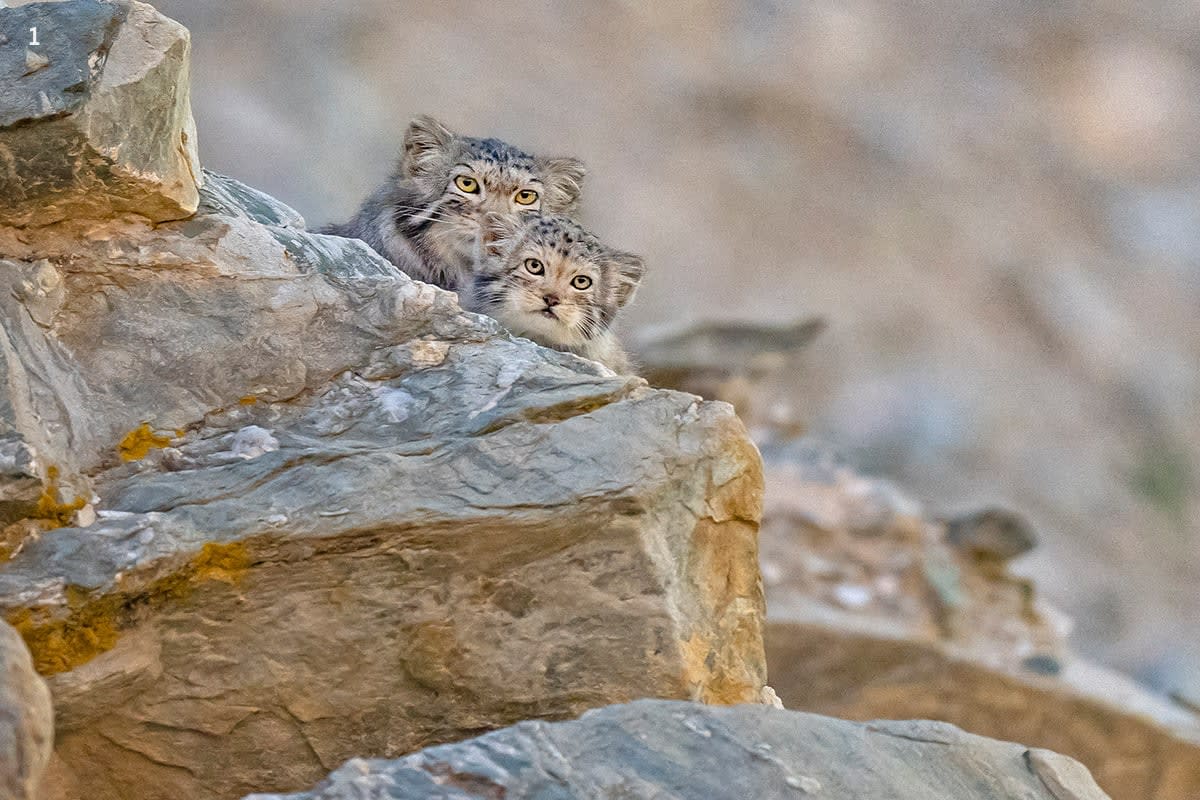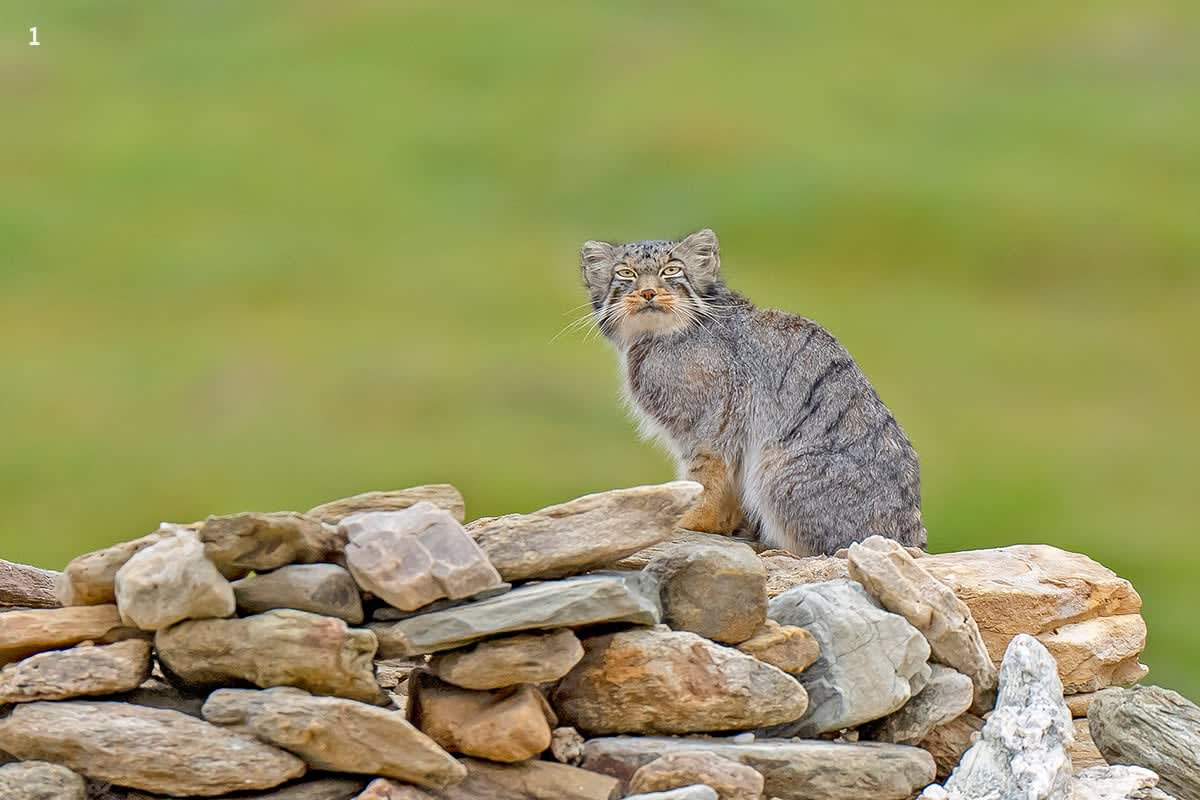 Listen to this article
•
15:34 min
Listen to this article
•
15:34 min
It is an old axiom that charm can be deceptive. This is certainly true for small cats. They are cute, pretty, innocent- and harmless-looking but silent killers. They terrorise small prey animals. Ask a small bird or a vole. All cats are predators, and killing prey is their survival instinct. They kill to eat.
Pallas’s cat (Octolobus manul) is a small cat weighing between 2.5 kg and 4.5 kg. It is a bit larger than the rusty-spotted cat (Prionailurus rubiginosus) considered the smallest wild cat in the world. Wild cats, particularly smaller species, flourish in the tropical and semi-tropical regions of Asia, Africa, and Central and South America. With 16 species, India has the highest cat diversity in the world. The Pallas’s cat has chosen to live in the cold, icy and windy habitat of the trans-Himalayas and high plateaus from Iran to Afghanistan and Central Asia, and from Tibet to south Siberia. In its vast distribution, it is widely but thinly distributed, generally where its favourite prey — pikas and voles — thrive. Like any cat, it is capable of killing any prey that it can subdue, but prefers pikas and voles that are small enough to kill easily.
Cover photo: The Pallas’s cat is an ambush hunter that hides secretly in the grass and waits. Once it spots prey, it pounces to kill.
The Pallas’s cat was first described in 1776 by Peter Simon Pallas from specimens collected near Lake Baikal, Russia. It is also called the steppe cat or rock wild cat. Although the Pallas’s cat was known to locals in Tibet and Mongolia (where its local name is manul — which is also its scientific name), it came into the limelight in India only around 2012 when pictures started appearing on social media. It was first recorded from Ladakh in 1971 and later from other Indian states like Sikkim and Uttarakhand.
Pallas’s cat’s other moniker, rock wild cat, is very appropriate as it lives amongst rocks and boulders of the steppes and grasslands. While the steppes provide it with prey, boulders help it to escape predators that can come either from the sky in the form of golden eagles or from the ground, such as Tibetan wolves. Loose boulders and caverns provide denning sites where they give birth. Generally, 2-5 kittens are born after a gestation period of 70-78 days. Only the mother raises the kittens; the father returns to a solitary life after impregnating a female. Like most cat species, the mortality of young ones is high, and only 1-2 kittens from a litter survive to adulthood.
During my frequent visits to Ladakh since the year 2005, I had never seen a Pallas’s cat. In June 2022, I learnt that many naturalists had seen a Pallas’s cat in the Hanle area of Ladakh. Additionally, wildlife photographer Dhritiman Mukherjee was already there filming and photographing this cute little cat. I had an irresistible urge to travel to Leh and went there in August 2022. For three days, we spent all our waking hours photographing and studying the cat. Three days of observations do not make me a Pallas’s cat expert, but I learnt the value of patience and concentration from my little friend. Every move of this tiny rascal is calculated to avoid detection by its prey. Pikas live in underground burrows in the steppes and wetlands that are drying up. They come out to feed on green grass, flowers, and seeds. While foraging, they do not want to be eaten up by a sharped-eye eagle or camouflaged, slow-moving cat. In this cat-and-pika game, a swift move is a question of life and death. Pikas that dive into the burrows in time live another day, but a slow one becomes food for the cat. The hungry kittens wait for their mother to succeed, which she often does.
One evening, we watched a kitten, the sole survivor of the litter, playing by itself for two hours around the den, waiting for its mother to bring food. It was a long wait for the hungry kitten, so it would lie near the mouth of the den, sleep for some time, and frequently wake up to look around. After many hours of wait, at dusk, its eyes brightened up as its mother approached with a pika in her mouth. I think the kitten saw it before we could see the mother. Dhritiman’s and his friend’s cameras went berserk while I observed through my binoculars as the mother quickly approached the den. The kitten was not in a hurry to eat, so it played with its dead prey for some time, drank the nourishing milk from its mother, and then started eating. After that, the kitten and mother played for some time before retiring to the comfort of the den. A successful day for us and for the Pallas’s cat family.

Thanks to its elusive nature, difficult habitat, vast distribution, and the controls on the fur trade, the Pallas’s cat is not a threatened species. With increasing conservation consciousness, change in the fashion industry and campaigns by animal rights activists since the 1980s, there has been a decline in the fur trade. It is no more fashionable to wear a coat or fur of wild cats. Many celebrities openly oppose the wild fur trade. The IUCN considers the cat of “Least Concern”. Even so, I am afraid its habitat is fast disappearing, particularly in Ladakh. For example, Hanle’s marshes/grasslands have almost disappeared through drainage, over-grazing by domestic animals, and the spread of agriculture, housing, plantations, and roads. Boulder mining is another threat. Over-grazing reduces the food of voles, pikas, and marmots that feed on fresh grasses, flowers, and roots/tubers. Roads in the marshes have changed the water flow, and the spread of agriculture has reduced the natural vegetation. We saw mining taking place 100 m from the Pallas’s cat’s den. Disturbance by unscrupulous photographers and tourists is another increasing menace. Some photographers want a picture by hook or by crook. For them, a photograph is the ultimate end, not the protection of the species and habitat. How long this tiny wild cat will survive in Ladakh, only time will tell. We must take habitat conservation measures now before the cat’s food and denning sites disappear. I hope with increasing attention to the Pallas’s cat, the authorities will restore the marshes and grasslands. With innovative measures, the Pallas’s cat can become a mascot and the main attraction for tourists to the Hanle marshes (along with the iconic black-necked cranes). Both these species are attractive enough to develop a mini-tourism industry in and around Hanle, benefitting local communities and wildlife.















